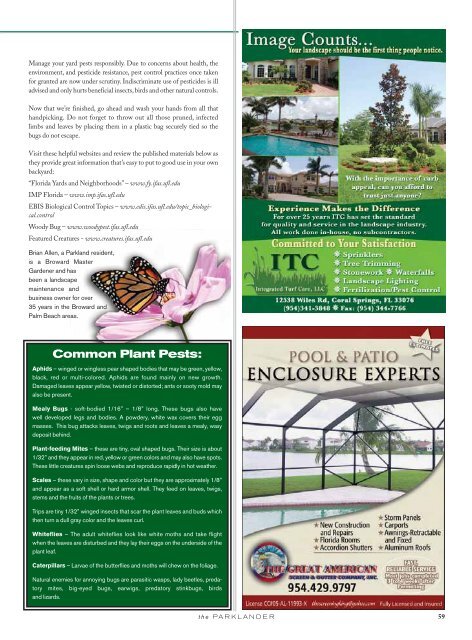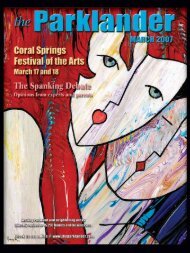February 2008 - The Parklander Magazine
February 2008 - The Parklander Magazine
February 2008 - The Parklander Magazine
- No tags were found...
Create successful ePaper yourself
Turn your PDF publications into a flip-book with our unique Google optimized e-Paper software.
Manage your yard pests responsibly. Due to concerns about health, theenvironment, and pesticide resistance, pest control practices once takenfor granted are now under scrutiny. Indiscriminate use of pesticides is illadvised and only hurts beneficial insects, birds and other natural controls.Now that we’re finished, go ahead and wash your hands from all thathandpicking. Do not forget to throw out all those pruned, infectedlimbs and leaves by placing them in a plastic bag securely tied so thebugs do not escape.Visit these helpful websites and review the published materials below asthey provide great information that’s easy to put to good use in your ownbackyard:“Florida Yards and Neighborhoods” – www.fy.ifas.ufl.eduIMP Florida – www.imp.ifas.ufl.eduEBIS Biological Control Topics – www.edis.ifas.ufl.edu/topic_biological.controlWoody Bug – www.woodypest.ifas.ufl.eduFeatured Creatures - www.creatures.ifas.ufl.eduBrian Allen, a Parkland resident,is a Broward MasterGardener and hasbeen a landscapemaintenance andbusiness owner for over35 years in the Broward andPalm Beach areas.Common Plant Pests:Aphids – winged or wingless pear shaped bodies that may be green, yellow,black, red or multi-colored. Aphids are found mainly on new growth.Damaged leaves appear yellow, twisted or distorted; ants or sooty mold mayalso be present.Mealy Bugs - soft-bodied 1/16” – 1/8” long. <strong>The</strong>se bugs also havewell developed legs and bodies. A powdery, white wax covers their eggmasses. This bug attacks leaves, twigs and roots and leaves a mealy, waxydeposit behind.Plant-feeding Mites – these are tiny, oval shaped bugs. <strong>The</strong>ir size is about1/32” and they appear in red, yellow or green colors and may also have spots.<strong>The</strong>se little creatures spin loose webs and reproduce rapidly in hot weather.Scales – these vary in size, shape and color but they are approximately 1/8”and appear as a soft shell or hard armor shell. <strong>The</strong>y feed on leaves, twigs,stems and the fruits of the plants or trees.Trips are tiny 1/32” winged insects that scar the plant leaves and buds whichthen turn a dull gray color and the leaves curl.Whiteflies – <strong>The</strong> adult whiteflies look like white moths and take flightwhen the leaves are disturbed and they lay their eggs on the underside of theplant leaf.Caterpillars – Larvae of the butterflies and moths will chew on the foliage.Natural enemies for annoying bugs are parasitic wasps, lady beetles, predatorymites, big-eyed bugs, earwigs, predatory stinkbugs, birdsand lizards.the PARKLANDER 59
















